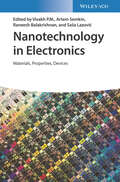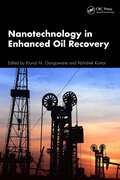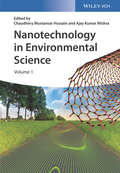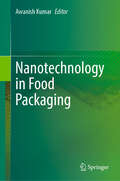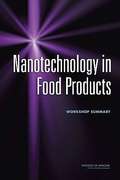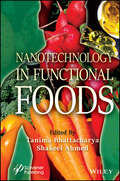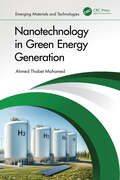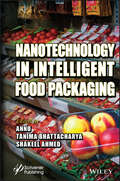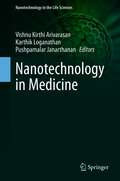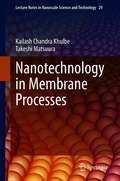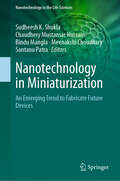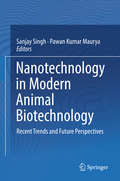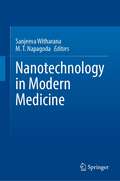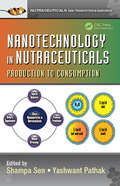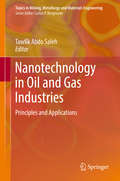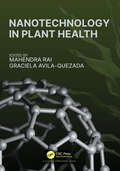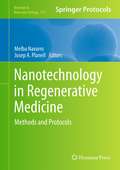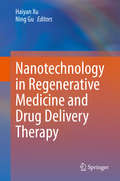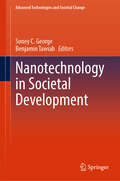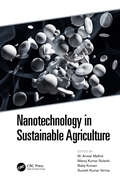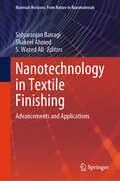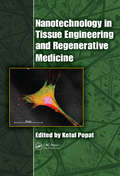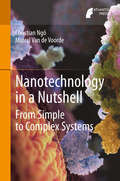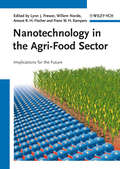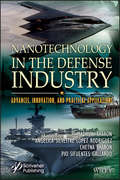- Table View
- List View
Nanotechnology in Electronics: Materials, Properties, Devices
by Visakh P. M. Raneesh Balakrishnan Artem Semkin Saša LazovićNanotechnology in Electronics Enables readers to understand and apply state-of-the-art concepts surrounding modern nanotechnology in electronics Nanotechnology in Electronics summarizes numerous research accomplishments in the field, covering novel materials for electronic applications (such as graphene, nanowires, and carbon nanotubes) and modern nanoelectronic devices (such as biosensors, optoelectronic devices, flexible electronics, nanoscale batteries, and nanogenerators) that are used in many different fields (such as sensor technology, energy generation, data storage and biomedicine). Edited by four highly qualified researchers and professionals in the field, other specific sample topics covered in Nanotechnology in Electronics include: Graphene-based nanoelectronics biosensors, including the history, properties, and fundamentals of graphene, plus fundamentals of graphene derivatives and the synthesis of graphene Zinc oxide piezoelectronic nanogenerators for low frequency applications, with an introduction to zinc oxide and zinc oxide piezoelectric nanogenerators Investigation of the hot junctionless mosfets, including an overview of the junctionless paradigm and a simulation framework of the hot carrier degradation Conductive nanomaterials for printed/flexible electronics application and metal oxide semiconductors for non-invasive diagnosis of breast cancer The fundamental aspects and applications of multiferroic-based spintronic devices and quartz tuning fork based nanosensors. Containing in-depth information on the topic and written intentionally to help with the practical application of concepts described within, Nanotechnology in Electronics is a must-have reference for materials scientists, electronics engineers, and engineering scientists who wish to understand and harness the state of the art in the field.
Nanotechnology in Enhanced Oil Recovery
by Abhishek Kumar Krunal M. GangawaneThis book presents an in-depth analysis of the various nanotechnologies that have been developed and their potential application in enhanced oil recovery (EOR). It begins with an introduction to EOR, and the current state of the oil and gas industry followed by discussion of various nanoparticles used in EOR, including metal and metal oxide nanoparticles, carbon-based nanoparticles, and composite nanoparticles.Features Explains the various mechanisms by which nanoparticles can enhance oil recovery, and the challenges and limitations of using nanotechnology in EOR. Provides a comprehensive analysis of how nanoparticles affect EOR, practical application, and simulation. Explores stepwise information about the utility of nanotechnology in EOR. Includes dedicated case study chapters to get an in-depth idea of EOR by using nanotechnology. Illustrates various essential parameters affecting the EOR. Discusses the challenges of nanotechnology-based EOR. This book is aimed at graduate students, researchers, and professionals in Petroleum and Chemical Engineering, and Nanotechnology.
Nanotechnology in Environmental Science
by Ajay Kumar Mishra Chaudhery Mustansar HussainAn overview of the current state of nanotechnology-based devices with applications in environmental science, focusing on nanomaterials and polymer nanocomposites. The handbook pays special attention to those nanotechnology-based approaches that promise easier, faster and cheaper processes in environmental monitoring and remediation. Furthermore, it presents up-to-date information on the economics, toxicity and regulations related to nanotechnology in detail. The book closes with a look at the role of nanotechnology for a green and sustainable future. With its coverage of existing and soon-to-be-realized devices this is an indispensable reference for both academic and corporate R&D.
Nanotechnology in Food Packaging
by Awanish KumarFor researchers and food industry professionals seeking a comprehensive, fully up to date single source on nanotechnology in food packaging, this text provides all the needed information. The book begins with a chapter on the current state of nanotechnology and its use in food packaging and the industry as a whole, including current advances in methods and technology. Further chapters address organic nano packaging for shelf life and quality retention, the use of inorganic nanomaterials, biopolymeric nano packaging and composite nano packaging materials. Nanotechnology in Food Packaging focuses on the methods of synthesis for nano-based food packaging materials and the fabrication of improved, active and smart packaging materials. Ethical issues and safety features of nanomaterials are addressed, plus the main challenges and regulatory aspects of nanomaterials in food products. An important chapter looks to the future of nanotechnology in the food packaging industry. Toxicological aspects, detection methods and analysis of nanomaterials are also covered in full. With its wide scope and up to date information on technological advancements, this is the perfect source for those seeking knowledge on the use of nanotechnology in the food industry.
Nanotechnology in Food Products: Workshop Summary
by Institute of Medicine of the National AcademiesIn the food industry, scientists are exploring the potential of nanotechnology to enhance the flavor and other sensory characteristics of foods, introduce antibacterial nanostructures into food packaging and encapsulate and deliver nutrients directly into targeted tissues, among other applications. However, as with any new technology, along with the benefits, there is the potential for unanticipated adverse effects. There is still a great deal to learn about any health outcomes related to introducing nanosized materials into foods and food packaging materials. Developing nanotechnology into a safe, effective tool for use in food science and technology will require addressing these and other questions. Assuring consumer confidence will be equally important to the success of this new emerging technology. The Institute of Medicine held a one-day workshop, summarized in this volume, to further explore the use of nanotechnology in food. Specifically, the workshop was organized around three primary topic areas: (1) the application of nanotechnology to food products; (2) the safety and efficacy of nanomaterials in food products; and (3) educating and informing consumers about the applications of nanotechnology to food products.
Nanotechnology in Functional Foods
by Tanima Bhattacharya Shakeel AhmedNANOTECHNOLOGY IN FUNCTIONAL FOODS The broad applicability of bioactive delivery systems for improving food quality, safety, and human health will make this book a valuable resource for a wide range of readers in industry, research, and academia. Functional foods is an emerging trend in the food industry, whose potential value is determined by whether they are safe with respect to consumer health. Nanotechnology in Functional Foods was written to help the reader better understand the benefits and concerns associated with these foods. In addition to giving an overview of the current state-of-the-art in functional foods, different aspects of the advanced research being conducted on their extraction, synthesis, analysis, and biological effects are presented. Besides focusing on several synthesis techniques, the book also discusses the application of nanoparticles in nutrient delivery and pharmaceuticals, such as nano-emulsions, solid lipid nanoparticles, and polymeric nanoparticles; their properties and interactions with other food components and their impact on the human body; the consumer acceptance and diversification of these nutrients. Moreover, new trends are discussed concerning the application of artificial intelligence in screening various components of functional foods. Audience The book will be central to food scientists, materials scientists, biotechnologists, medicinal chemists, pharmacists, and medical professionals. Tanima Bhattacharya, PhD, is a formulation scientist, who completed her Doctoral degree in Food Processing & Nutrition Science from the Indian Institute of Engineering Science and Technology, Shibpur, West Bengal, India and gained overseas post-doctoral experience from the College of Chemistry and Chemical Engineering Hubei University of China. She has published several scientific research articles in international peer-reviewed journals, and her research interests include the fabrication of biocompatible nanostructures and studying their properties and applications in the area of food science, technology, and biomedical sciences. Shakeel Ahmed, PhD, is an assistant professor of Chemistry at the Higher Education Department, Government of Jammu and Kashmir, India. His PhD degree in Chemistry is from Jamia Millia Islamia, A Central University, New Delhi. He has published several research publications in the area of green nanomaterials and biopolymers for various applications including biomedical, packaging, and water treatment. He has published more than 20 books in the area of nanomaterials and green materials.
Nanotechnology in Green Energy Generation (Emerging Materials and Technologies)
by Ahmed Thabet MohamedNanotechnology in Green Energy Generation provides a comprehensive review of modelling, processing, and applications of all major categories of green energy generation materials. It explores different areas of green energy generation including hydrogen, solar, and wind energies, covering aspects such as synthesis, morphology, materials, and characterization.Presenting the fundamental principles in the design and utilization of green energy generation materials, the book discusses the construction and equivalent circuits of traditional and new green energy cells. In addition, it provides thermal analysis and comparative studies with traditional power generation, including operation and cost-efficiency of new generation cells and modules. The book also includes many case studies, laboratory experiments, and research results throughout the chapters.The book will be a valuable reference for applied researchers, academic researchers and graduate students studying advances in energy engineering, nanotechnology, and materials and composites.
Nanotechnology in Intelligent Food Packaging
by Shakeel Ahmed Annu Tanima BhattacharyaNANOTECHNOLOGY IN INTELLIGENT FOOD PACKAGING This book is a state-of-the-art exposition of nanotechnology and food packaging which is undergoing rapid advancement. This book is specially designed with an emphasis on the state-of-the-art in nanotechnology and food packaging. It offers fascinating techniques for producing smart and active food packaging and also discusses its toxicity and the role that nanosensors play in detecting different pathogens in food packaging. The concluding chapters also explain recent developments concerning the incorporation of health supplements in food packaging and their future role in producing intelligent food packaging. The 16 chapters of this book were contributed by academic and industry experts working in their respective areas of research and are thoughtfully arranged in a systematic fashion that preserves the flow of knowledge. An attempt has been made to include all the information in a single monograph to better understand the topics and technologies involved in the application of nanotechnology in intelligent food packaging. Audience The book is aimed at researchers, industry scientists such as chemists, biologists, polymer technologists, food packaging industrialists, biotechnologists, health experts, quality/food safety officials, and policymakers. It will also be helpful to graduate students in the fields of materials science, polymer science, and biotechnology to better understand the fundamental concepts involved in food packaging in relation to extending shelf life.
Nanotechnology in Medicine (Nanotechnology in the Life Sciences)
by Vishnu Kirthi Arivarasan Karthik Loganathan Pushpamalar JanarthananNanomedicine is the field of science that deals with organic applications of medicine at the nano-scale level. It primarily addresses finding, anticipating, and treating sickness, as well as using nanotechnology to assist in controlling human frameworks at the cellular level. The nature of nanotechnology allows it to address numerous medical issues in humans. This book offers comprehensive information to better comprehend and apply multifunctional nanoparticles in nanomedicine, and thus open avenues in the field.Medicating at the nanolevel is an exceptional therapeutic avenue, as it avoids symptoms associated with conventional medicines. This book investigates recent insights into structuring novel drug delivery frameworks. It concentrates on the physical characteristics of drug delivery transporters, and the preliminary procedures involved in their use. The book offers in-depth detail that benefits academics and researchers alike, containing broad research from experts in the field, and serves as a guide for students and researchers in the field of nanomedicine, drug delivery, and nanotechnology.
Nanotechnology in Membrane Processes (Lecture Notes in Nanoscale Science and Technology #29)
by Takeshi Matsuura Kailash Chandra KhulbeNanotechnology has been established in membrane technology for decades. In this book, comprehensive coverage is given to nanotechnology applications in synthetic membrane processes, which are used in different fields such as water treatment, separation of gases, the food industry, military use, drug delivery, air filtration, and green chemistry. Nanomaterials such as carbon nanotubes, nanoparticles, and dendrimers are contributing to the development of more efficient and cost-effective water filtration processes. Gas separation and carbon capture can be significantly improved in flue gas applications. Nanoporous membrane systems engineered to mimic natural filtration systems are being actively developed for use in smart implantable drug delivery systems, bio artificial organs, and other novel nano-enabled medical devices. The microscopic structure of nanoporous ceramic membranes, mainly focusing on zeolite materials, as well as the energy-saving effect of membrane separation, contribute to various chemical synthesis processes. In the food industry, nanotechnology has the potential to create new tools for pathogen detection and packaging. For each application, nanotechnology is mostly used to make composite membranes, and the book provides a detailed look at the mechanisms by which the composite membrane works in each application area.
Nanotechnology in Miniaturization: An Emerging Trend to Fabricate Future Devices (Nanotechnology in the Life Sciences)
by Chaudhery Mustansar Hussain Sudheesh K. Shukla Bindu Mangla Santanu Patra Meenakshi ChoudharyNanotechnology is rapidly growing as a new technology alternative to create advance materials with unique characteristics and performance for vast applications in a range of industrial sectors. In recent years, a number of nanotechnology-based products have appeared in our day-to-today lives. On the other hand, industries have also considered nano-concepts to produce high-added value products with superior capacity, reliability, and efficiency. The field of nanotechnology is one of the most popular areas for current research and development in almost all technical disciplines. This includes miniaturization of microelectronics, nanomedicine, nano-emulsion particles, fuel cell catalysts, self-assembled polymer films, nanofabrication, imprint lithography, and more. This book summarizes recent advances in miniaturization using nanotechnological approaches. The ability to interact with matter at nanoscale has led to the development of nanoarchitecture and nanomaterials which have the capability of exceeding the limits of conventional modalities. This book provides insight into the development and trends which are progressing quickly in the field of nano-miniaturized-based devices and tools. This book offers an overview of the evolution of miniaturization of engineering systems and devices, which was initiated over one-half century ago. The trend of further miniaturization of devices to the ultimate atomic scale will not only continue, it will become a dominant technological development in the first half of the new century, if not for longer. Such development will require significant changes in every aspect of design and manufacturing, as well as production management over traditional engineering practices. Production of miniaturized device components and engineering systems of micro- and nanoscale is clearly beyond the capability of current machine tools. Manufacturing of nano-scaled devices and components involves isolation, transportation, and re-assembly of atoms and molecules. This nanomachining technology involves not only physical-chemical processes as in the case of microfabrication, but it also involves application and integration of the principles of molecular biology.
Nanotechnology in Modern Animal Biotechnology: Recent Trends and Future Perspectives
by Pawan Kumar Maurya Sanjay SinghThe book introduces the basic concepts of nanotechnology and the various technologies to characterize nanomaterials. It also covers the nanostructural features of mammalian cells/tissues and related nanomechanical properties. In addition, the book comprehensively describes the current state-of-the-art and future perspectives of nanotechnology in biosensors. It also discusses the potential of nanotechnology for delivering the diverse cancer therapeutics and illustrates its limitation due to the potential toxicity associated with oxidative stress. It also highlights the ethical issues and translational aspects related to nanotechnology. Finally, it summarizes the applications of nanotechnology in animal biotechnology, the recent perspectives and future challenges of nanomedicines. The content of the book are beneficial for the undergraduate, postgraduate and doctoral students as well the professionals working in the area of nanotechnology and nanomedicines.
Nanotechnology in Modern Medicine
by Sanjeeva Witharana M. T. NapagodaThis book highlights the applications of nanotechnology in modern medicine. Today we are living in a world of fast-changing behavior and lifestyles. Despite health and wellbeing are often pronounced and enforced, the diseases and illnesses are emerging in different forms, at an alarming rate. Protecting the mankind is becoming ever more challenging. In this backdrop, medicine needs new approaches and technologies to build the defenses. Nanotechnology is successfully confronting the situation. It does so in two avenues, namely, nanomaterials, and, nanodevices. Nanomaterials possess extraordinary properties that are utilized to confront bacteria and viruses, and for targeted drug delivery. Nanodevices can be maneuvered inside the human body to reach extreme locations. This book presents the latest developments in these areas.
Nanotechnology in Nutraceuticals: Production to Consumption (Nutraceuticals #4)
by Yashwant Pathak Shampa SenWhile nutraceuticals were verified to be expedient, they often lack stability, bioavailability, and permeability, and nano-nutraceuticals are being developed to afford a solution to the problem. Nanotechnology in Nutraceuticals: Production to Consumption delves into the promises and prospects of the application of nanotechnology to nutraceuticals, addressing concepts, techniques, and production methods. Nutraceuticals retain less stability, efficacy, and bioavailability when entering the human body. To overcome such problems, nanotechnology shows promise when applied as a tool to improve the quality and stability of nutraceuticals. This book discusses metallic nanoparticles and their applications in the food industry with specific application to nutraceuticals. It includes detailed discussion on potential functional properties of nutraceuticals with regard to antimicrobial activity, anti-inflammatory activity, and anti-cancer activity. Since nanoparticles can be toxic past a certain limit, implementing nanotechnology under thoughtful regulations is considered critical. The book addresses these issues with chapters covering the principles for the oversight of nanotechnologies and nanomaterials in nutraceuticals, the implications of regulatory requirements, the ethics and economics of nano-nutraceuticals, and consumer acceptance of nanotechnology based foods.
Nanotechnology in Oil and Gas Industries
by Tawfik Abdo SalehThis book provides a powerful source to develop new, rapid and highly efficient materials for the application in various fields of oil and gas fields. It focuses on the synthesis, characterization and applications of various Nanomaterials, presenting the state-of-the-art in developments and innovations in nanocomposites. This book provides the complete practical and theoretical information about the synthesis of nanoparticles with potential use in the field of oil and gas.
Nanotechnology in Plant Health
by Mahendra Rai Graciela Avila-QuezadaNanotechnology is an emerging, pivotal platform for enhancing plant health. On one hand, nanomaterials serve as crucial nutrients and nanofertilizers, while on the other, they have demonstrated their potential for diagnosing plant diseases, delivering fungicides and pesticides, and providing therapeutic solutions against diseases caused by pathogens and parasites.The book Nanotechnology in Plant Health explores the significance of nanomaterials in plant nutrition, nanofertilizers, and their role in managing plant pathogens, including the most formidable ones like quarantined strains. This unique publication represents a global team of contributors and stands out for its comprehensive coverage of plant nanonutrients, nanofertilizers, and nano-plant protectors.
Nanotechnology in Regenerative Medicine
by Josep A. Planell Melba NavarroNanotechnology plays a key leading role in developing tools able to identify, measure, and study cellular events at the nanometric level as well as in contributing to the disclosure of unknown biological interactions and mechanisms, which opens the door for advances including nanodevices for diagnostic and therapy, drug delivery systems, and regenerative medicine. In Nanotechnology in Regenerative Medicine: Methods and Protocols, expert researchers in the field provide an overview of a very wide range of currently used technologies and methods that involve nanotechnology principles applicable to tissue regeneration. Being that the application of nanotechnology to regenerative medicine is a very broad field, this book focuses its interests on particular areas such as its use as a means to produce efficient platforms and structures for tissue engineering, delivery systems and biosensors, as well as the use of some techniques to study materials surfaces and the interactions between cells, biomolecules, and surfaces at the nanoscale. Written in the highly successful Methods in Molecular BiologyTM series format, chapters include introductions to their related topics, lists of the necessary materials and reagents, step-by-step, readily reproducible laboratory protocols, and tips on troubleshooting and avoiding known pitfalls. Authoritative and accessible, Nanotechnology in Regenerative Medicine: Methods and Protocols provides established scientists, junior researchers, and students involved in the bioengineering, biotechnology, and biomedical fields with a sound foundation in a variety of vital nanotechnology approaches in regenerative medicine.
Nanotechnology in Regenerative Medicine and Drug Delivery Therapy
by Haiyan Xu Ning GuThe book focuses on the application of nanotechnologies in scaffold-guided tissue regeneration and in drug delivery systems for use in immunotherapy and overcoming drug resistance in cancer treatment. It covers a variety of topics, including nanomaterials for immunomodulation and immnunotherapy; molecular studies on self-assembly for peptides and DNA and related applications in tumor diagnosis and therapeutics and against human pathogenic bacteria; magnetic and conductive scaffolds for guiding tissue regeneration; multiple functions of magnetic nanoparticles in drug delivery and regenerative medicine; and re-purposing of traditional medicine in nano-formulations. In addition, it discusses common effects of nanomaterials, including reactive oxygen species and protein corona. Providing valuable insights and the presenting the latest research advances, the book allows readers to gain a systematic understanding of the topic.
Nanotechnology in Societal Development (Advanced Technologies and Societal Change)
by Soney C. George Benjamin TawiahThis book investigates the complex effects of nanotechnology across numerous fields such as nanomedicine, tailored therapy in medicine and health care, transformational treatment choices for various illnesses, electronics, and computing via miniaturization. In addition, the contributions of nanotechnology to quantum computing, and flexible electronics has been examined. More so, the book discusses the advantages of nanotechnology in the energy and environmental sectors, such as solar cells, energy storage systems, and water purification technologies, in order to solve major global concerns. The impact of nanotechnology on materials and production processes, with applications in construction, aerospace, and other fields, is highlighted. The book further discusses the ethical and societal issues such as safety, privacy, equal access, and thoroughly examined how to strike a balance between innovation and responsible development of nanotechnology in the context of stringent rules and proactive risk assessment. Furthermore, the ability of nanotechnology to bridge the technological divide in underdeveloped nations while minimizing environmental implications is also highlighted.
Nanotechnology in Sustainable Agriculture
by M. Anwar Mallick, Manoj Kumar Solanki, Baby Kumari, and Suresh Kumar VermaNanotechnology in Sustainable Agriculture presents applications of nanobiotechnology for eco-friendly agriculture practices. Implementing sustainable agriculture techniques is a crucial component in meeting projected global food demands while minimising toxic waste in the environment. Nano-technological tools – including nanoparticles, nanocapsules, nanotubes and nanomolecules – offer sustainable options to modernise agriculture systems. Written by nanotechnology experts, this book outlines how nano-formulations can improve yield without reliance on chemecial pesticides and reduce nutrient losses in fertilization. It reveals how nanotools are used for rapid disease diagnostics, in treating plant diseases and enhancing the capacity for plants to absorb nutrients. Features: Combines nanotechnology and agronomy presenting applications for improving plant performance and yields. Reveals nanotechnology-based products used for the soil and plant health management which mitigate climate change. Discusses roles of microbial endophytes, heavy metal nanoparticles and environment health, nano-nutrients, phytochemicals, green bioengineering and plant health. This book appeals to professionals working in the agriculture and food industry, as well as agricultural scientists and researchers in nanotechnology and agronomy.
Nanotechnology in Textile Finishing: Advancements and Applications (Materials Horizons: From Nature to Nanomaterials)
by Shakeel Ahmed S. Wazed Ali Satyaranjan BairagiThis book is focused on the latest developments and practical applications of nanotechnology in textile finishing. It covers the fundamentals of nanotechnology, including the properties and behavior of nanoparticles, and how they can be used to enhance the performance of textiles. The book also explores the various types of nanomaterials that are used in textile finishing, such as nanoparticles, nanocomposites, and nano-coatings, and their properties, advantages, and limitations. The book covers the different types of textile finishing techniques, including dyeing, printing, and coating, and how nanotechnology is used to improve their performance. It also covers the environmental, health, and safety aspects of using nanotechnology in textile finishing, and the challenges and opportunities that lie ahead. The book is targeted at textile scientists, engineers, and researchers working in the textile industry, as well as students and academics in textile science and engineering. It is also useful for those in related fields, such as materials science, chemistry, and chemical engineering.
Nanotechnology in Tissue Engineering and Regenerative Medicine
by Ketul PopatAlthough nanotechnology applied to medicine has a potentially huge impact on drug delivery and tissue engineering, significant challenges need to be resolved before clinically viable nanomedicine or nanobiomedicine therapies will be available. Skillfully edited, with contributions from an expert panel of researchers, Referred to as "nanomedicine" or "nanobiomedicine," the application of nanotechnology to medicine can impact diagnosis, monitoring, and treatment of diseases, as well as the control and understanding of biological systems. Bringing together an unparalleled field of experts, this volume explores various aspects of nanotechnology and its applications in biomedical fields. The book uses an application-oriented approach to relate laboratory-based research to the development of technologies that are easily adaptable to an industry environment, focusing chiefly on drug delivery, tissue engineering, and regenerative medicine.
Nanotechnology in a Nutshell
by Christian Ngô Marcel Van de VoordeA new high-level book for professionals from Atlantis Press providing an overview of nanotechnologies now and their applications in a broad variety of fields, including information and communication technologies, environmental sciences and engineering, societal life, and medicine, with provision of customized treatments. The book shows where nanotechnology is now - a fascinating time when the science is transitioning into complex systems with impact on new products. Present and future developments are addressed, as well as a larger number of new industrial and research opportunities deriving from this domain. An overview for professionals, researchers and policy-makers of this very rapidly expanding field. Brief chapters and colour figures with a contained overall length make the book attractive at an attractive price - a must for every professional's shelf. Mihail C. Roco, National Science Foundation and National Nanotechnology Initiative, wrote the preface underlying the importance and weight of the present book to this exciting and epoch-awakening field of research and applications: "Nanotechnology is well recognized as a science and technology megatrend for the beginning of the 21st century. This book aims to show where nanotechnology is now - transitioning to complex systems and fundamentally new products - and communicates the societal promise of nanotechnology to specialists and the public. Most of what has already made it into the marketplace is in the form of "First Generation" products, passive nanostructures with steady behaviour. Many companies have "Second Generation" products, active nanostructures with changing behaviour during use, and embryonic "Third Generation" products, including 3-dimensional nanosystems. Concepts for "Fourth Generation" products, including heterogeneous molecular nanosystems, are only in research. "
Nanotechnology in the Agri-Food Sector: Implications for the Future
by Lynn J. FrewerProviding an overview of nanotechnology in the context of agriculture and food science, this monograph covers topics such as nano-applications in teh agri-food sector, as well as the social and ethical implications. Following a review of the basics, the book goes on to take an in-depth look at processing and engineering, encapsulation and delivery, packaging, crop protection and disease. It highlights the technical, regulatory, and safety aspects of nanotechnology in food science and agriculture, while also considering the environmental impact. A valuable and accessible guide for professionals, novices, and students alike.
Nanotechnology in the Defense Industry: Advances, Innovation, and Practical Applications
by Madhuri Sharon Angelica S. Rodriguez Chetna Sharon Pio Sifuentes GallardoThis book will be about various aspects related to applications and use of knowledge of nanotechnology in promoting defense activities. The area in which scientists are focusing includes (i) nano-devices such as sensors, GPS & computers, chemical & biological weapons, nano-fabrics, bulletproof materials, nano-stealth coating, use of nanotechnology in various areas of aerospace. It is intended to cover available methodologies and understanding of technologies for these applications. Not only for destructive but also to improve medical and casualty, safety care for soldiers, and to produce lightweight, strong and multi-functional materials for use in body armour, both for protection and to provide enhanced connectivity will be covered.
